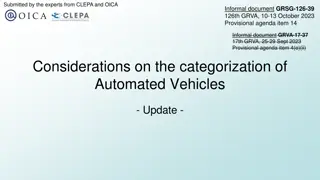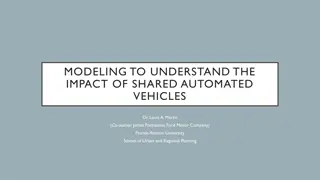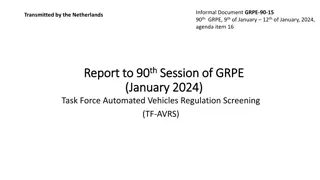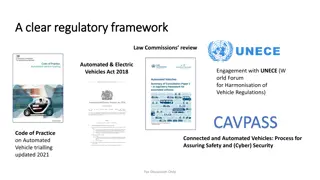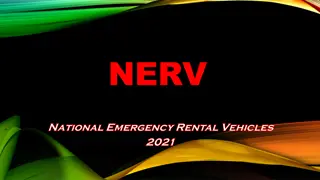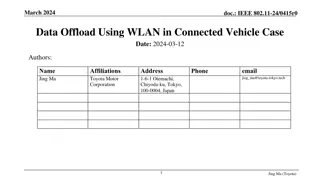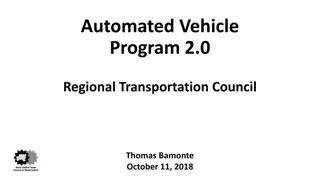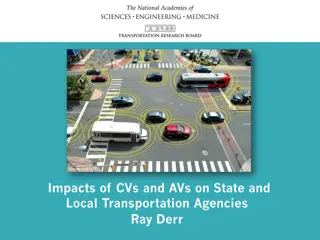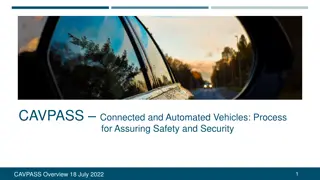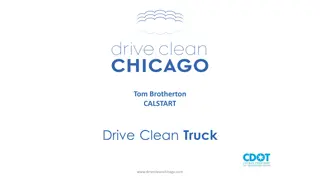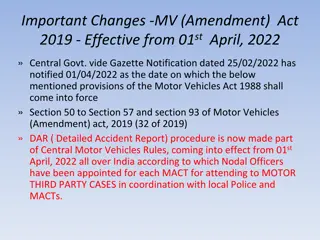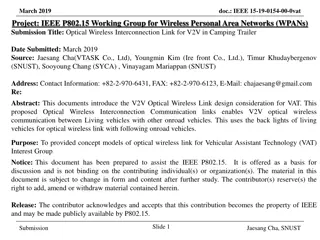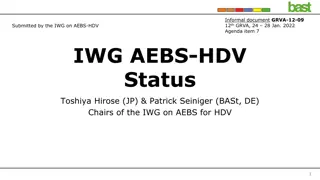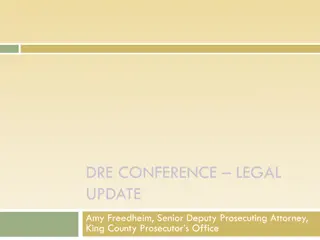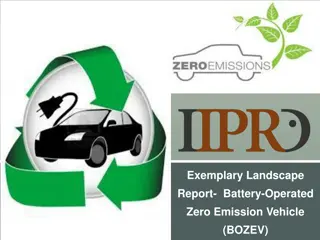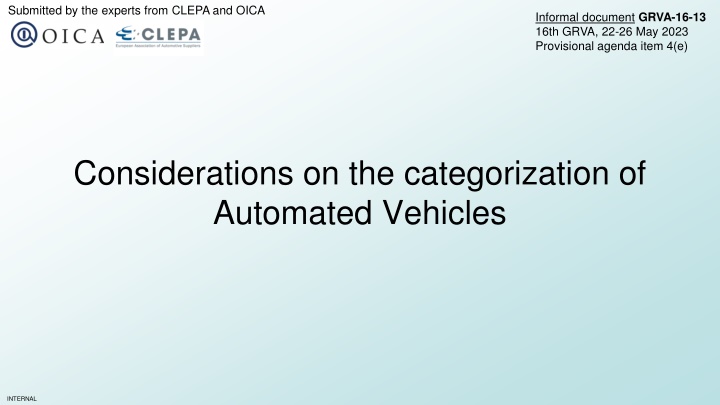
Considerations on the categorization of Automated Vehicles
Review existing vehicle categories for automated vehicles (AVs) and proposes new subcategories to address different AV use cases. The aim is to ensure that regulations align with specific AV use cases and provide a logical structure for categorization.
- automated vehicles
- vehicle categories
- dual-mode vehicles
- driverless vehicles
- low-speed AVs
- goods transportation
- passenger transportation
Download Presentation

Please find below an Image/Link to download the presentation.
The content on the website is provided AS IS for your information and personal use only. It may not be sold, licensed, or shared on other websites without obtaining consent from the author. Download presentation by click this link. If you encounter any issues during the download, it is possible that the publisher has removed the file from their server.
E N D
Presentation Transcript
Submitted by the experts from CLEPA and OICA Informal document GRVA-16-13 16th GRVA, 22-26 May 2023 Provisional agenda item 4(e) Considerations on the categorization of Automated Vehicles INTERNAL
Motivation for reviewing the existing vehicle categories Check if : Existing categories are working for Automated Vehicles It is ensured that the different ADS use-cases are covered The application of regulations to the specific use cases fits well A logical structuring of the use cases under the existing vehicle categories is possible Outcome: Existing categories cannot be used as they are currently defined, without modification New approach has to be defined to address different ADS vehicle use cases
Prerequisits for the new categorization concept for AVs Balanced approach between number of AV categories vs. ADS use-case specific requirements in each individual Regulation Keep current logic for basic vehicle categorization Resolve existing issues for categories, e.g. issue of small shuttles with standing passengers Easy application in existing WVTA frameworks ADS use-case provisions in non-ADS Regs dedicated AV categories
Vehicle categorization under R.E.3 New sub categories for Automated Vehicles (AV s) Subcategory A Driverless Vehicles with ADS Subcategory D Dual Mode vehicles Subcategories X & Y Low speed driverless AV s Designed primarily for the carriage of people Designed primarily for the carriage of goods Designed primarily for the carriage of people Designed primarily for the carriage of goods With or w/o passengers Examples: Examples: N1A N1 M1A M1 M1D M2X Driver seat + max. 8 add. seats, no limitation of GVM seated only, max. 9 seats GVM </= 3.5t GVM </= 3.5t e.g. Robotaxi < [25] km/h e.g. Campus shuttle N2 N2A M2A M2 N3D Driver seat + more than 8 add. seats, GVM max. 5 t More than 9 seats or standing passengers, GVM Max. 5t 3.5t < GVM </= 12t 3.5t < GVM </= 12t M2Y e.g. Hub-2-Hub truck N3 M3 M3A [25] km/h </= v </= [50] e.g. Urban shuttle M1Z N3A Driver seat + more than 8 add. seats, GVM exceeding 5 t GVM > 12t More than 9 seats or standing passengers, GVM exceeding. 5t GVM > 12t e.g. AVP equipped vehicle *Class I, II, III and Class A, B can be carried over Vehicles which can be driven manually under nominal conditions AV s which do not require a driver/fallback-ready user
Categories according to Consolidated Resolution R.E.3 Required amendments to existing Definitions: 2.2. 2.2.1. Category M - Power-driven vehicles having at least four wheels and used for the carriage of passengers "Category M1": Vehicles used for the carriage of passengers and comprising not more than eight nine seats in addition to the driver's seat. "Category M2": Vehicles used for the carriage of passengers, comprising more than eight nine seats in addition to the driver's seat or designed to carry standing passengers, and having a maximum mass not exceeding 5 tonnes. "Category M3": Vehicles used for the carriage of passengers, comprising more than eight nine seats in addition to the driver's seat or designed to carry standing passengers, and having a maximum mass exceeding 5 tonnes. Vehicles of categories M2 and M3 belong to: For vehicles having a capacity exceeding [23] occupants 22 passengers in addition to the driver, there are three classes of vehicles: 2.2.4.1.1. "Class I": Vehicles constructed with areas for standing passengers, to allow frequent passenger movement. 2.2.4.1.2. "Class II": Vehicles constructed principally for the carriage of seated passengers, and designed to allow the carriage of standing passengers in the gangway and/or in an area which does not exceed the space provided for two double seats. 2.2.4.1.3. "Class III": Vehicles constructed exclusively for the carriage of seated passengers. 2.2.4.1.4. A vehicle may be regarded as belonging in more than one class. In such a case it may be approved for each class to which it corresponds. 2.2.4.2. For vehicles having a capacity not exceeding [23] occupants 22 passengers in addition to the driver, there are two classes of vehicles: 2.2.4.2.1. "Class A": Vehicles designed to carry standing passengers; a vehicle of this class has seats and shall have provisions for standing passengers. 2.2.4.2.2. "Class B": Vehicles not designed to carry standing passengers; a vehicle of this class has no provision for standing passengers. 2.2.2. 2.2.3. 2.2.4. 2.2.4.1.
Categories according to Consolidated Resolution R.E.3 New categories: New Dual-mode sub category: 2.x. Dual-mode vehicles with Automated Driving Systems 2.x.1. Definition. Dual-mode vehicles are vehicles of category M or N which can be driven manually and which are equipped with an Automated Driving System allowing the vehicle to be driven in an automated mode not issuing a Transition Demand, requiring an interaction by a driver to take back manual control (e.g. a fallback-ready user). 2.x.2 Categorization Dual-mode vehicles are categorized into two categories, based on the maximum operational design speed of the Automated Driving System. In cases were the Automated Driving System consists of multiple features, e.g. low-speed and high-speed ADS features, the feature with the highest maximum design speed is defining the maximum design speed of the Automated Driving System and therefore considered for the dual-mode categorization. 2.x.2.1. Category D are dual mode vehicles having a maximum operational speed of the Automated Driving System exceeding [25] km/h. 2.x.2.2. Category Z are dual mode vehicles having a maximum operational speed of the Automated Driving System not exceeding [25] km/h. 2.x.3. Combined designation Symbols M and N may be combined with symbol D or Z. For example, a vehicle of category M1 which is suited for dual-mode use having a maximum operational speed of the Automated Driving System exceeding [25] km/h may be designated as M1D.
Categories according to Consolidated Resolution R.E.3 New categories (continued): New Driverless Vehicles sub category: 2.y. Category A Driverless vehicles with Automated Driving Systems 2.y.1. Definition. Driverless vehicles are vehicles of category M or N which are equipped with an Automated Driving System allowing the vehicle to be driven in an automated mode not issuing a Transition Demand, requiring an interaction by a driver to take back manual control (e.g. a fallback- ready user) and which [cannot be driven manually under nominal conditions/are not falling under the definition of dual mode vehicles]. 2.y.2. Combined designation Symbols M and N may be combined with symbol A. For example, a vehicle of category M1 which is considered an driverless vehicle shall be designated as M1A. New Low speed driverless vehicles sub categories: 2.z. Low-speed driverless vehicles with Automated Driving Systems 2.z.1. Definition 2.z.1.1. Category X are vehicles belonging to category A, but having a maximum design speed not exceeding [25] km/h. 2.z.1.2. Category Y are vehicles belonging to category A, having a maximum design speed exceeding [25] km/h but not exceeding [50] km/h 2.z.2. Combined designation Symbols M and N may be combined with symbol X or Y. For example, a vehicle of category M1 which is considered a low-speed driverless vehicle of Category Y shall be designated as M1Y.
Vehicle categorization: Dual Mode vehicles* Since the main vehicle design from a vehicle category point of view is driven by the manually operated vehicle, it may be appropriate to use existing categories + an addition subclassification comparable to off road => G , e.g. D for dual mode automated vehicles => M1D, N1D, ... Dual mode vehicles Non ADS- System regulations Which specifics will have to be considered under automated mode for non-ADS system regulations? ADS regulation 1) Replace driver reference adequately 2) HMI (incl. warnings) to consider passengers in general (where applicable) Compliance in automated mode Compliance in manual mode 3) Amending/supplementing e.g. testing conditions as appropriate (=> testing?, self assessment/ declaration?) Additionally considering ADS performance assessment (performing DDT in the ODD) Existing approval process & regulations (unchanged) Additional requirements/ checks may become necessary depending on the regulation New ADS regulation using ODD based framework and NATM appproach * AV s which do not require a driver/fallback-user
Thank you INTERNAL

